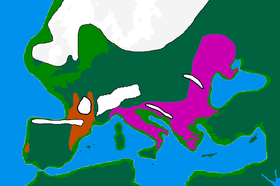Epigravettian
 | |
| Alternative names | Tardigravettian |
|---|---|
| Geographical range | Southern and Eastern Europe |
| Period | Late Upper Paleolithic |
| Dates | ~21,000 – 10,000 cal. BP [1] |
| Type site | None (because likely a continuation of the Gravettian) |
| Major sites | Paglicci, Arene Candide, Riparo Tagliente, Dolní Věstonice |
| Preceded by | Gravettian |
| Followed by | Mesolithic cultures |
| Defined by |
Georges Laplace, 1958 (broader-than-modern meaning)[2] Broglio, Laplace et al., 1963 (modern meaning, as “Tardigravettiano”)[3] |
The Epigravettian (Greek: epi "above, on top of", and Gravettian) was one of the last archaeological industries of the European Upper Paleolithic. It arose after the Last Glacial Maximum around ~21,000 cal. BP. It is related to the Gravettian, of which it is considered a continuation by some scholars (e.g. G. Laplace). In this sense, the Epigravettian is simply the Gravettian after ~21,000 BP, when the Solutrean had replaced the Gravettian in most of France and Spain.
Its known range extends from southeast France to the western shores of the Volga River, Russia, with a large number of sites in Italy. It was replaced by Mesolithic cultures around 10,000 BP.
References
- ↑ Montoya, Cyril (2004). Les traditions techniques lithiques à l’Épigravettien: Analyses de séries du Tardiglaciaire entre Alpes et Méditerranée (Ph.D.) (in French). Université de Provence. p. 5.
- ↑ G. Laplace. "Recherches sur l'origine et l'évolution des complexes leptolithiques. Le problème des Périgordiens I et II et l'hypothèse du synthétotype aurignaco-gravettien. Essai de typologie analytique". Quaternaria (in French). 4. pp. 133–164.
- ↑ A. Broglio; G. Laplace; F. Zorzi. "I depositi quaternari di Ponte di Veia. Le industrie". Memorie del Museo Civico di Storia Naturale di Verona (in Italian). 11. pp. 325–367.
This article is issued from
Wikipedia.
The text is licensed under Creative Commons - Attribution - Sharealike.
Additional terms may apply for the media files.